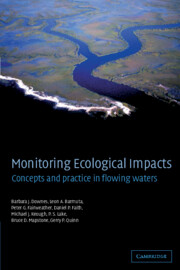Book contents
- Frontmatter
- Contents
- Preface and Acknowledgements
- Part I Introduction to the nature of monitoring problems and to rivers
- Part II Principles of inference and design
- 4 Inferential issues for monitoring
- 5 The logical bases of monitoring design
- 6 Problems in applying designs
- 7 Alternative models for impact assessment
- Part III Applying principles of inference and design
- References
- Index
4 - Inferential issues for monitoring
Published online by Cambridge University Press: 21 August 2009
- Frontmatter
- Contents
- Preface and Acknowledgements
- Part I Introduction to the nature of monitoring problems and to rivers
- Part II Principles of inference and design
- 4 Inferential issues for monitoring
- 5 The logical bases of monitoring design
- 6 Problems in applying designs
- 7 Alternative models for impact assessment
- Part III Applying principles of inference and design
- References
- Index
Summary
This book will recommend a variety of statistical designs and analyses for detecting human impacts in rivers and streams. The aim of this chapter is to provide the basic principles of statistical inference for understanding these designs. We assume some prior statistical background, and suggest you read the first few chapters of a good introductory applied statistics text, such as Sokal and Rohlf (1995). We will take a classical, frequentist approach in this chapter that covers confidence intervals and P (probability) values from statistical tests of hypotheses. We also consider the alternative Bayesian approach for interpreting probabilities and making decisions. The logic of designing a rigorous monitoring program to detect the effects of specific human activities in fresh water is, however, relatively independent of the debate between frequentists and Bayesians and our preference is for the classical methods. We emphasize the importance of developing statistical models that match the design chosen for monitoring flowing waters. The statistical model acts as a guide for analysis. With it, we can construct an analysis of variance (ANOVA) table and try to determine how much of the variation in a response variable (such as nutrient concentration, species diversity etc.) is accounted for by the influence of predictor variables (such as current velocity, human activity, time etc.). These statistical models also allow us to test specific hypotheses of interest; for example, is there a difference in mean species richness between locations upstream and downstream of a sewage discharge? The analyses we will use are very dependent on underlying assumptions and we stress the importance of checking those assumptions before drawing conclusions from the analyses.
- Type
- Chapter
- Information
- Monitoring Ecological ImpactsConcepts and Practice in Flowing Waters, pp. 45 - 114Publisher: Cambridge University PressPrint publication year: 2002



